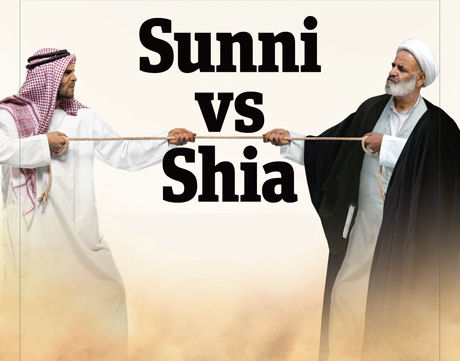![]()
Tue, Jan 03, 2012 | Rubin Reports | By Barry Rubin

Cover of the June 20, 2011 New Statesman edition on the Sunni and Shia power struggle in the Middle East. (New Statesman; www.newstatesman.com)
Sunni versus Shia: The Middle East’s New Strategic Conflict
A different version of this article appeared in the Jerusalem Post.
Of course, conflicts between Sunni and Shia Muslims are not at all new, but the fact that this is becoming a central feature on the regional strategic level is a dramatic shift. After all, as long as there were secular-style regimes preaching an all-inclusive Arab nationalist identity, differences between religious communities were subordinated. Once there are Islamist regimes, theology becomes central again, as it was centuries ago.
However, no one should misunderstand the situation. This is fundamentally a struggle for political power and wealth. When Sunni and Shia states or movements battle they are acting as political entities not pursuing old theological disputes.
The growing power and influence of Iran’s Islamist regime posed a tremendous problem for Arab Sunni Islamists. They generally did not like Iran because it was Persian and Shia, yet it was the only Islamist game in town. Thus, Arab Sunni Islamist Hamas became an Iranian client. The Iran-Iraq war reflected these antagonisms, as best seen in Iraqi propaganda. Yet Iraq’s regime was also able to keep the Shia majority there under control.
Saddam Hussein’s removal by a U.S.-led international intervention opened up the question of confessional relations in Iraq. The Arab Shia were inevitably going to win any election, given their three-to-one advantage over the Sunni and the Kurds opting out for what is, in effect though not name, their own state in the north. Despite the terrorist, anti-American, and al-Qaida elements of the Sunni insurgency, it was essentially a last-ditch attempt by the Sunnis to reclaim power. It failed and while violence continues, the main Sunni emphasis will be on negotiating the best possible division of power.
In Lebanon, the Shia triumphed too, led by Hizballah and aided by Syria and Iran. But all of this was prelude to the year 2011. The “Arab Spring” was an overwhelmingly Sunni affair, their own equivalent in some ways of Iran’s 1979 revolution. Only in Bahrain, where they were repressed, did the Shia take the offensive.
Egypt, Tunisia, and Libya all had Sunni insurgencies against Sunni Arab governments. The situation in Syria is far more complex with an Alawite non-Muslim regime that pretends to be Shia Muslim and is allied with Iran, opposed by a variety of rebels. Nevertheless, in this context, the upheaval is a Sunni-led (though far from just Islamist) revolt against a “Shia” regime.
Here’s the bottom line: Sunni Arab Islamists no longer need Iran or even Turkey because they now have their own power. What is likely to emerge is at least a loose Sunni Arab and largely Islamist-flavored bloc consisting of Egypt, the Gaza Strip, Libya, and Tunisia along with the Muslim Brotherhood elements in Jordan and Syria.
The key element here is the Muslim Brotherhood, an organization that doesn’t like Shia Muslims in general and Iran in particular. Little events, like Brotherhood guru Yusuf al-Qaradawi’s support for the Sunni regime in Bahrain against the Shia opposition, show the direction of their thinking. The even more radical Salafists — a term now used for the small revolutionary Islamist groups, are even more anti-Shia. One factor here is the continued unwillingness of the majority of Arab states to welcome Shia-ruled Iraq into their ranks. Iraq is not going to become a satellite of Iran. It certainly feels more comfortable in a Shia bloc but will probably continue to be relatively uninvolved in regional affairs.
Note, too, that to a large extent this situation leaves the Palestinian Authority as an orphan. While it can depend on very general Arab, Iranian, and Turkish support, the Islamists prefer to back Hamas, especially the ever-stronger Sunni Islamists. This, of course, encourages the Palestinian Authority’s (Fatah’s) alliance with Hamas while also weakening its leverage toward that Islamist partner. (And that means a continued disinterest in negotiating with Israel, much less reaching a negotiated solution with it.)
Thus, despite appearances, 2011 was a defeat for Iran and Turkey because Sunni Arab Islamists are far less receptive to Tehran’s influence and view it as a rival, while Arab Islamists don’t want leadership from Turks either.
Can these blocs unite effectively against the United States, the West or Israel? In a word: No. Their power struggles for regional power and for control of individual states (Bahrain, Lebanon, Syria, and to a far lesser extent Iraq) will keep them in conflict. Even on the anti-Israel consensus each side will seek to exploit it for their own, often conflicting, interests.
By the same token, however, the hope for moderation is minimal. In a region when regimes and movements are competing to prove their militancy and loyalty to a radical interpretation of Islam, nobody is going to want to make peace with Israel. And regimes will only work with the United States if they feel that America can and will protect them, a rather forlorn hope with an Obama Administration eager to make friends with Islamists.
There is also another aspect to this Sunni-Shia rivalry, the formation of blocs, the competition in militancy, and the battle for control of individual states. The region will continue to waste lives, time, and resources in political strife as the lure of ideology and power rather than pragmatism and economic productivity. This is still rule even if the old regimes have fallen.



 RSS
RSS










Sunni versus Shia: The Middle East’s New Strategic Conflict | Middle East, Israel, Arab World, South http://t.co/HAfT9P00
Sunni versus Shia: The Middle East’s New Strategic Conflict | Middle East, Israel, Arab World, South http://t.co/HAfT9P00
I found this article on Sunni-Shi'ite tension in the ME interesting: http://t.co/TFMjyXUJ
Sunni vs. Shia: The ME's New Strategic Conflict – http://t.co/H63J7v9K